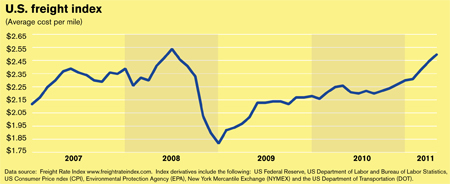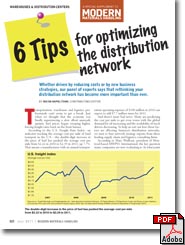Transportation, warehouse and logistics professionals can’t seem to get a break. Just when we thought that the economy was finally experiencing a slow albeit unsteady upturn, fuel prices began creeping higher, forcing freight rates back on the front burner.
According to the U.S. Freight Rate Index—an indicator tracking the average cost per mile of land transport in the U.S.—the double-digit increase in the price of fuel has pushed the average cost per mile from $2.22 in 2010 to $2.39 in 2011, up 7.7%. That means a manufacturer with an annual transportation operating expense of $100 million in 2010 can expect to add $7.7 million more for 2011.
And there’s more bad news: Many are predicting the cost per mile to get even worse with the global demand for oil increasing and the availability of truck drivers decreasing. To help us sort out how these factors are affecting America’s distribution networks, we turn to four network strategy experts from three leading supply chain and logistics consulting firms.
According to Marc Wulfraat, president of Montreal-based MWPVL International, the key question many companies are now evaluating is: At what point does it make economic sense to add more distribution facilities to reduce inbound and outbound miles?
Paul Evanko, senior vice president of York, Pa.-based St. Onge Company, agrees with Wulfraat’s question. “Many are making the move toward smaller distribution centers located close to major markets, to ports, and to inland-intermodal logistics centers.”

But it isn’t only the price of fuel that has shippers rethinking their distribution networks. The implementation of new business strategies has also been another major driver. “Almost every company that we’ve helped with logistics strategy in the last two years is reengineering their logistics network to either enhance customer service or to help launch a new customer channel,” says Todd Soller, retail strategist for global firm Kurt Salmon.
Mike Jones, president of St. Onge, is also seeing the same changing business strategy scenario play out in many of the studies that his firm is doing. “Recent network studies have not only been initiated by ongoing mergers or acquisitions, but also by corporate edicts looking for cross-divisional synergistic opportunities,” says Jones. “With the latter, while the individual businesses may operate with great autonomy, the corporate parent still wants them to look at opportunities to share distribution and supply chain resources.”
Whether driven by reducing costs or by new business strategies, rethinking your distribution network has now become more relevant than ever. With typical cost savings of 15% and more, these studies also result in allowing companies to service their customers more quickly. “This can make a huge difference with how a company is perceived by its customer,” notes Soller.
“The ability to get product to market in one to two days when the competition can only deliver in three to five days is considered to be a serious weapon,” says Wulfraat. “It may be worth it to spend more to buy more market share.”
Which begs the question: Is your network up to par? In the next few pages, our experts share six essential tips for network modeling success. With a combined 83 years of experience and more than 150 network studies under their belts, you might want to heed their advice as you optimize your network.
Tip 1: Traditionally, in many DC projects, business owners and stakeholders don’t get involved until the very end when they give their approval on the overall output. But in a network strategy study, our experts agree that engaging high-level management early on is a must.
“Don’t have them show up on the 15th week of a 16-week study and start throwing curve balls and challenging the assumptions,” explains Jones. “Get them involved from the beginning to establish your assumption sets.”
Soller also recommends involving managers from sourcing, product development, merchandising, and sales to get all of their perspectives for inclusion in the overall solution design. “These managers bring perspectives to the table that make the overall result much more effective; it also ensures buy-in and belief that the new network is a good decision for the business.”
Soller cites, for example, how a sales manager can bring to light specific needs of individual customers, allowing you to address them within the network, rather than creating a one-size-fits-all solution for all customers.
Tip 2: A good distribution network redesign encompasses a number of key areas of the business that all need to be considered and questioned.
Wulfraat lists some of critical questions that need to be answered: What are the storage and throughput capacity constraints associated with my existing distribution network? What perceived service level requirements are required for major markets being served in order to be competitive? If the delivery lead-time is changed then what is the anticipated impact on sales revenues for a given market?
What are the logistics operating expenses, one-time expenses, inventory assets and capital investments required for the baseline scenario? How do these compare to alternative scenarios?
Evanko then points to a few questions concerning different forms of sourcing: Should you be sourcing your products locally, importing or returning manufacturing to the U.S. or to countries closer—also known as near-shoring?
Our experts agree that despite the buzz, near-shoring is not imminent. In fact, they expect most companies to continue to outsource the manufacturing of low-value items such as toys and clothes to China. “As labor becomes more expensive in China, then manufacturing isn’t moving back here. It will move further south in Asia into Indonesia, Malaysia, Vietnam and India,” says Evanko. “Those countries still have a labor cost advantage over China.”
Tip 3:Up to a certain scale, modeling your network in house using home-grown spreadsheets and databases can get cumbersome—if not impossible. Choose one of many commercially available network modeling tools.
“These tools can help a company develop a very robust initial solution and build the capability within your organization to continually monitor what’s happening within the logistics network,” explains Soller.
Wulfraat cautions, however, against solely depending on these tools to optimize the network. “A software tool will help to figure out a small but important subset of the overall information that is needed for a study,” he says. “But truthfully, the CEO does not care if you used a hammer or a drill for the job. The CEO wants to understand the financials, customer service impacts, and risk sensitivities.”
What’s the consensus? In any good network model redesign, you need both. “It’s important to involve the business owners within the organization in conjunction with using the analytics available in the tools,” concludes Soller. “The business owners help you ask the right questions and the tools assist you in developing more sophisticated answers to those questions.”
Tip 4:According to St. Onge’s Evanko, one of the most overlooked areas in many network designs is inventory. While adding more DCs may reduce transportation costs, it also requires you to carry more inventory—and many times this inventory is far from optimal. “But it can be made optimal by coordinating an inventory optimization study with the network design study,” says Evanko.
After the modeling tool identifies the number of facilities needed and roughly where they should be located, Evanko suggests using algorithms to determine the right amount of inventory to achieve a specific level of service that can be customized for each of the facilities.
Jones points out that how you deploy inventory becomes more and more important the more facilities you have: What products are you going to stock? Where are you going to stock them? “We’re getting customers wanting us to supplement the network study to answer more tactical level questions,” says Jones. “It’s not just how many facilities and where they’re located, but how am I going to deploy the inventory, route my trucks, and in some cases look at the design of the facilities themselves.”
Tip 5:Certain areas have become hotbeds for distribution primarily because of their proximity to the U.S. population.
Evanko points out, however, that these popular areas that companies gravitate toward means that there could be fierce competition for the labor force. Turnover rates become high because workers would rather work down the street for another DC that’s offering 25 cents more an hour.
He recommends analyzing the local labor market of the candidate locations to determine not only if there’s an adequate labor supply, but also to determine if socio-demographic characteristics are amenable to jobs in light manufacturing and distribution.
Tip 6:Depending on the complexity of the network, the availability of the data, and the experience of the project team, a typical network study can take up to six months.
“I’m amazed at how many companies are making big, multi-million dollar decisions, but for some reason don’t spend the time to do it right,” says Jones. “They have to do it in five to six weeks. Most of these studies rarely take less than three or four months to do right.”
About the Author
Follow Robotics 24/7 on Linkedin
Article topics
Email Sign Up
















